Website surveys remain one of the most impactful approaches to get feedback from your customers. No matter what kind of business you run, collecting user feedback can provide invaluable insights to improve their experience and boost conversions.
At the same time, a survey’s success depends on asking the right questions to ensure insightful and relevant feedback. In this post, we’ll provide survey question examples for different scenarios, along with actionable tips and real-life illustrations.
Content:
- What is a website survey, and what is it for?
- Top website survey questions
- Website usability survey questions
- Website redesign survey questions
- Exit-intent survey questions
- Lead generation survey questions
- User segmentation survey questions
- Post-purchase survey questions
- How to launch a website survey with SendPulse
- Create a survey
- Customize your survey
- Set display rules
- The bottom line
What is a website survey, and what is it for?
Website surveys are means for companies to collect qualitative and quantitative user feedback directly from a website. These surveys typically consist of a combination of open-ended and closed-ended questions, or they might stick to only one type.
Businesses can gather a wide range of valuable information by utilizing website surveys, including:
- Customer feedback. Surveys allow business owners to understand how users perceive and interact with their products or services.
- User experience insights. By collecting feedback, website surveys show ways to enhance the overall user experience. It may involve optimizing website design, layout, or even content to better meet user needs and expectations.
- Product or service feedback. Website surveys can also help you obtain insights about specific products or services offered on your website that might benefit future product development and updates.
- Customer contact details. Besides different sorts of feedback, surveys can help businesses win new customers by collecting their contact details. This way, companies can later provide leads with relevant product information and motivate them to purchase.
As you can see, you can deploy different website survey types depending on your marketing needs. However, you should also consider your survey placement since it plays a huge role in obtaining relevant information, too. Here’s where you can display your survey:
- Landing pages. You can publish surveys on landing pages to gather feedback from visitors interested in particular products or services.
- Thank-you pages. After a visitor has completed a desired action, you can present a survey to collect information about their experience with your brand, customer support, etc.
- Content pages. It’s also possible to integrate surveys directly into relevant content areas, such as blog posts or product pages. This can help you effectively segment your audience.
Apart from the placement on your website, online surveys can come in various formats, for example, pop-up quizzes or dedicated full-page questionnaires. Depending on the type of information you want to obtain, the proper placement and format can make or break your survey’s success. By keeping all these details in mind, businesses can increase the likelihood of engagement from website visitors at various touchpoints throughout their journey.
Top website survey questions
In this section, we’ll go over various website survey questions you can ask your visitors to collect all kinds of website or product feedback or essential information to get to know your audience better.
Website usability survey questions
A website usability survey is a method for understanding how usable your website is for visitors. By conducting this type of survey, you can assess various factors affecting your website’s overall user experience, such as page loading speed, content, navigation, mobile responsiveness, etc. It allows you to identify visitors’ concerns appearing while interacting with your website, uncover the reasons behind high bounce rates, improve conversion funnels, and enhance user satisfaction and loyalty.
Here are some tips on how to create a compelling website usability survey:
- Define objectives. Clearly state the purposes of your survey and the insights you hope to gain from it.
- Keep it concise. Website visitors are more likely to complete your survey if it has a limited number of questions.
- Mix question types. Incorporate rating scale, open-ended, and multiple-choice questions to gather quantitative and qualitative data.
- Ensure accessibility. Make sure users can access your survey from various devices and browsers.
Take a look at how NerdCow implements a simple NPS survey to understand customer satisfaction after interacting with their website. The company also asks an open-ended survey question to give their site visitors the freedom to answer in as much or as little detail as they like.
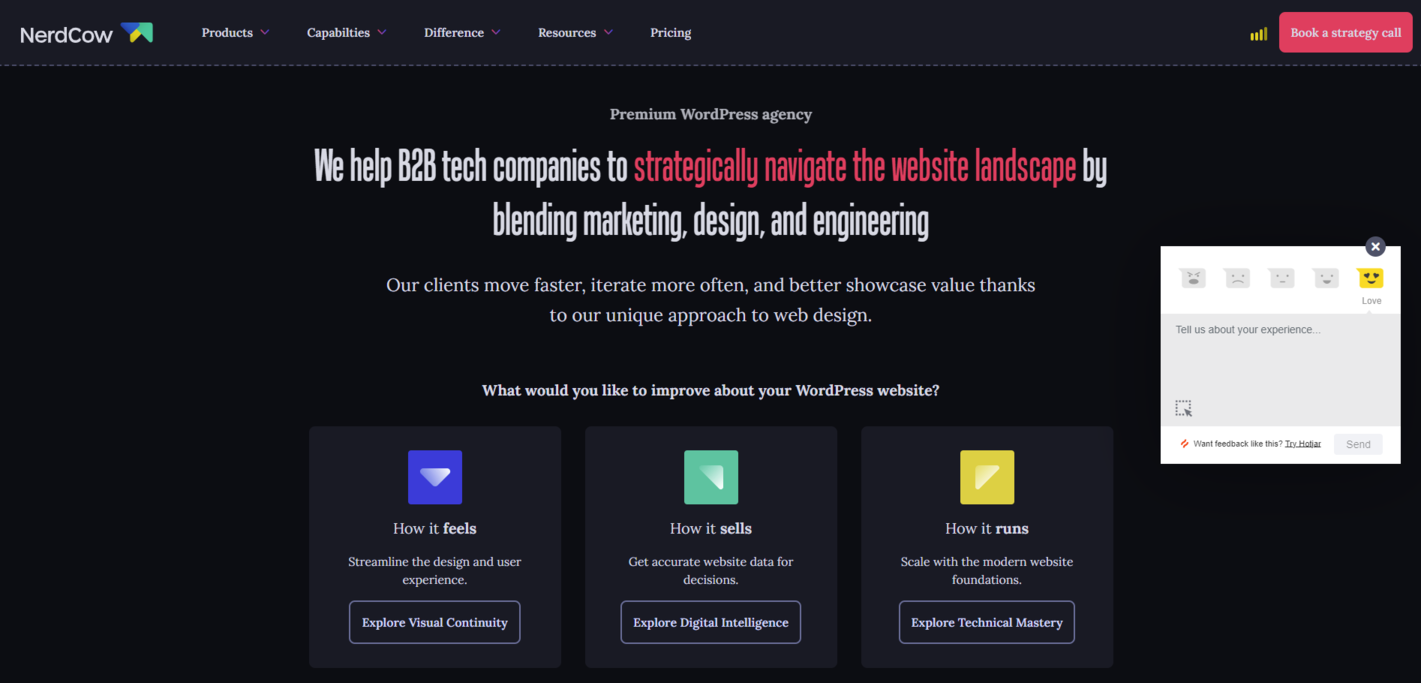
Here are some examples of website usability survey questions covering various aspects of user experience:
- How would you rate your overall experience on our website?
- Did you find it easy to navigate through our website?
- How clear and understandable was the information provided on the website?
- How satisfied are you with the loading speed of our website pages?
- Did our website function well and display correctly on your mobile device?
- Did you find what you were looking for?
- Did you find the content on our website relevant to your interests?
- Do you agree that our website is user-friendly?
- What is your opinion on the visual design of our website?
- Based on your experience today, how likely are you to return to our website in the future?
Asking the right website usability survey questions is essential to understanding your website visitor behavior and optimizing their experience, so make sure to tailor these examples to your individual business needs.
Website redesign survey questions
A website redesign survey aims to gather feedback from users regarding their preferences, opinions, and suggestions for or after improving a website’s design. This survey typically covers various aspects like layout, navigation, visual aesthetics, functionality, and overall satisfaction with the current website. The data collected from this survey can help businesses ensure that the updated website meets its users’ needs and expectations, eliminating problems that might have occurred in the past.
Here are some points to consider while creating a website redesign survey:
- Make it clear. Write straightforward questions that are easy to understand. Avoid using jargon or technical language that may confuse your website visitors.
- Think about logical order. Organize your survey so that it starts with general questions about overall impressions before diving into specifics. A good practice is incorporating skip logic into your surveys for a personalized experience.
- Include a pre-survey introduction. You can start your survey by explaining its purpose and expressing gratitude to users who participate in it.
Also, there are four principal stages in a website redesign process, and your survey questions may vary depending on the stage you’re at:
- Discovery phase. Identify the strengths and weaknesses of your website.
- Strategy phase. Create a plan for a new website based on user data you previously obtained.
- Development phase. Craft the visual elements and implement the coding.
- Testing phase. Ensure that the redesigned website aligns with user expectations and refine it if needed.
Here is a website survey example The British Museum conducted once it relaunched its website. It also opted for an NPS survey to gather quantitative data. Since the new website is live, The British Museum asks a post-redesign survey question related to the testing phase to determine if its website requires any further adjustments.
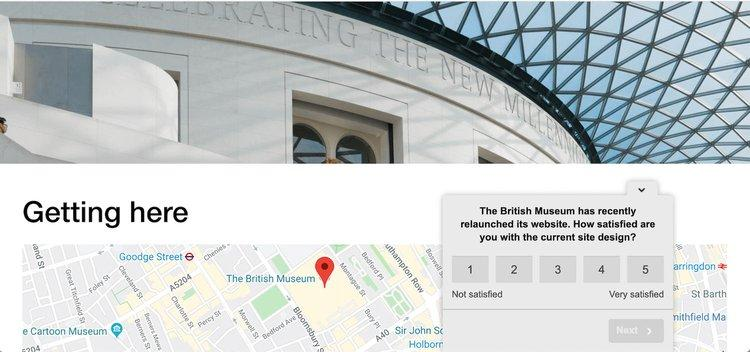
Below are several website survey questions you can ask at your redesign discovery stage:
- How often do you visit our website?
- What are the primary reasons for visiting our website?
These are a few website survey questions that can come in handy during the strategy phase:
- On a scale of 1 to 10, how satisfied are you with the current layout of our website?
- What aspects of the current website design do you find most challenging to navigate?
- Are there functionalities on our current website that you find particularly useful?
During the website redesign development stage, you can use survey questions like these:
- Do you find the new font size and style comfortable to read?
- Have you encountered any technical errors while browsing our website?
- Is the layout of the navigation menu easy to use?
Following are several examples of testing stage survey questions:
- How well does the website work on your device?
- How satisfied are you with the accessibility features on the website?
These questions can be used as inspiration or a starting point when crafting a website redesign survey. Consider mixing different questions to get the most accurate and comprehensive results.
Exit-intent survey questions
An exit-intent survey is usually triggered when a user is about to leave a website and typically appears as an overlay pop-up. This survey aims to capture feedback from users who haven’t completed a desired action, like purchasing or filling out a form. Implementing exit-intent website surveys can help you narrow the gap between customers’ intent and conversions, and ultimately manage bounce rates.
When creating your exit-intent survey, keep these points in mind:
- Focus on specifics. Instead of asking general questions, inquire about specific aspects that might have led to an uncompleted action. For example, your survey questions could be price- or choice-related.
- Ask about users’ goals. It’s important to know your visitor’s initial intent for coming to your website. Understanding their goals can provide valuable context for interpreting their feedback.
- Ask for reasons. Ask visitors directly why they decided to leave without completing an action. This information can help you identify areas for improvement.
- Choose the right time. Set up your survey to pop up at an appropriate time so it won’t disrupt user experience. You can use users’ cursor movements to detect when they actually intend to leave your page.
- Allow comments. You can’t predict every reason someone might leave your website, so give users a space to leave their comments.
Here’s a website survey example designed to identify any obstacles stopping users from placing an order. CalcWorkshop opted for a concise “yes/no” survey format for this purpose. Since it’s on the pricing page, the survey is triggered when a visitor spends a considerable amount of time on it, and only if it’s not their first time on the site.
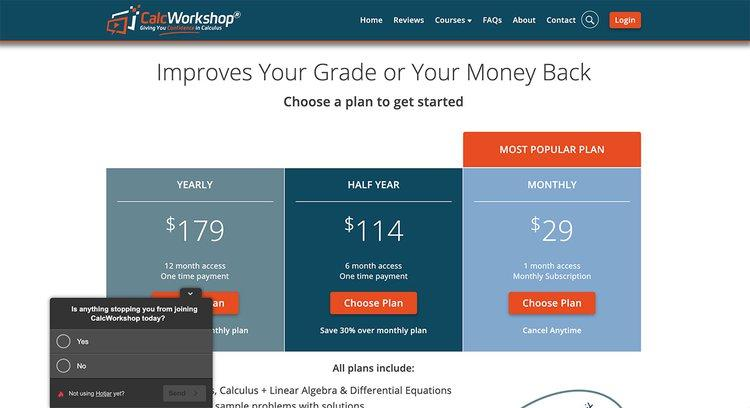
These surveys often include questions about the user’s reasons for leaving a website and their overall experience. Here are some examples:
- What was your primary goal when visiting our website today?
- Did you encounter any difficulties while navigating our website? If so, please specify.
- Were you able to find the information or product you were looking for?
- On a scale of 1 to 10, how would you rate your overall experience on our website?
- What prevented you from placing an order today?
- Did you experience any technical issues while using our website?
- How likely are you to return to our website to make a purchase in the future?
- Is there anything else we can do to assist you with your purchasing decision?
- What other features or products would you like to see on our website?
- Is there any other feedback you would like to share about your experience today?
By posing exit-intent survey questions and analyzing responses, website owners can better understand user behavior, preferences, and needs. This information will eventually help them address issues that cause visitors to leave their website and reduce churn rates.
Lead generation survey questions
Companies use lead generation surveys to gather information from potential customers and people who have expressed interest in their products or services. These surveys often include questions about users’ demographics, interests, preferences, and contact data. Later, companies can use this information to create personalized marketing messages and offers, thereby improving engagement and conversion rates.
There are a few tips you can follow to create an effective survey for generating leads:
- Prioritize questions. Write and place the most important questions at the beginning of your survey. Then, present the rest of your survey questions to prevent respondents from dropping out before they answer your key questions.
- Use closed-ended questions. Multiple-choice or scale questions are often easier to answer and provide quantifiable data for analysis. You can add follow-up questions based on the initial response to get more detailed data.
- Employ conditional branching. Not every question is relevant to every user. So, you can direct some users to an alternative path and ask questions that align with their previous replies. This user-centric approach will save respondents’ time and decrease dropout rates.
For example, Foodspring offers a questionnaire that helps users identify sports products that meet their needs. The company sends this information to an email address that a visitor provides at the end of the survey. This way, Foodspring generates leads while also offering value to prospects.
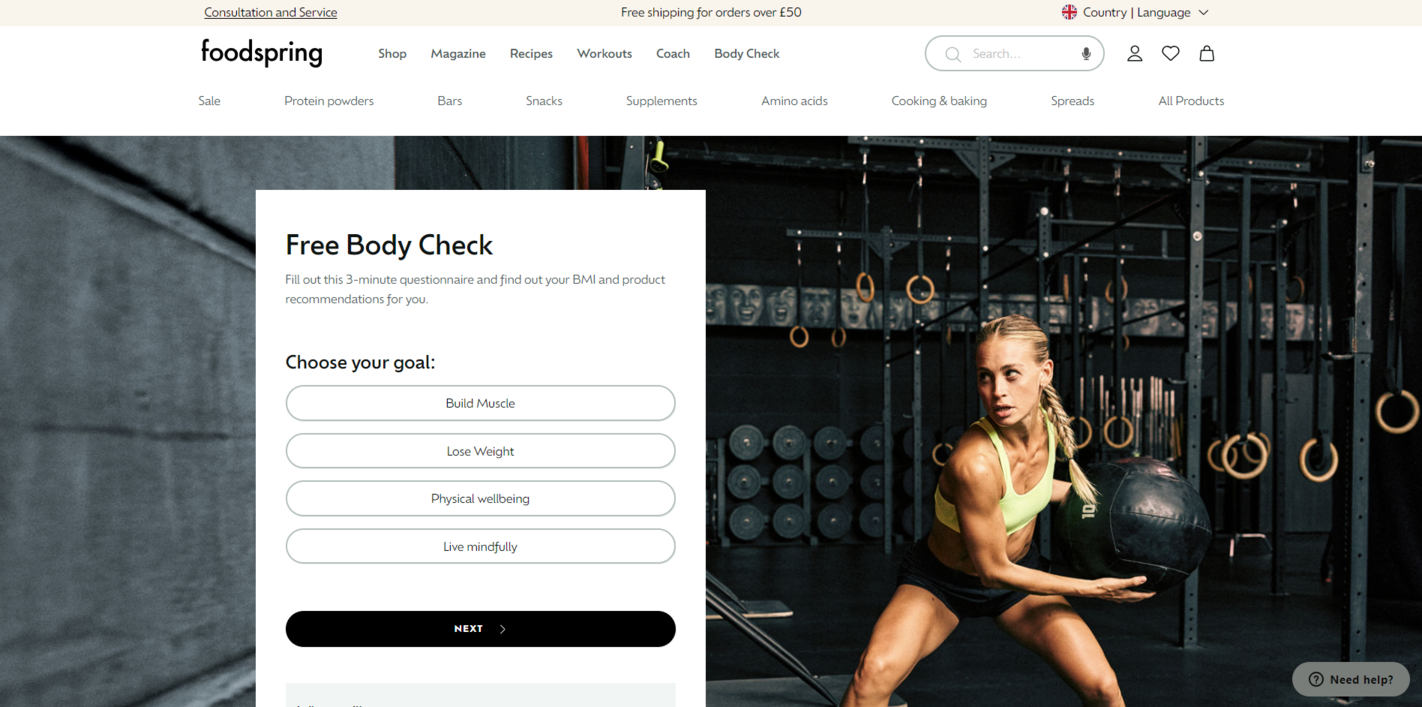
Here is a list of questions you can use for your lead generation survey:
- What is your primary reason for visiting our website today?
- Which industry best applies to you?
- What is your role within your organization?
- How would you rate your current level of satisfaction with your existing solution/provider?
- What specific challenges or pain points are you experiencing in your business that you hope our product/service can address? (Open-ended)
- Are you interested in receiving more information about our product/service?
- What is your preferred method of communication?
- How soon are you looking to implement a solution to address your current needs?
- Would you like a representative to contact you to discuss your requirements further?
- Could you please provide your contact details?
These questions aim to capture essential information about the lead’s needs, preferences, and readiness to engage further with your company. You can adjust them to better match the type of products or services you offer and your target audience.
User segmentation survey questions
A user segmentation survey is a method for grouping users into different categories based on specific criteria. Companies use these surveys to collect information about users’ demographics, preferences, behavior, and other factors that can help them better understand their audience. By segmenting users, companies can personalize their approach and target their efforts more effectively, eventually leading to higher customer satisfaction, engagement, and retention.
Here are some tips for you to create website surveys aimed at user segmentation:
- Define your segmentation criteria. It is essential to know which criteria you’ll use to approach and segment users. These could include demographics, geographics, behaviors, or purchasing history.
- Ask relevant questions. Craft survey questions that are clear and relevant to your segmentation goals.
- Enable open-ended questions. Your website visitors can provide valuable information you might not have considered.
Look at this segmentation survey by MasterClass. It categorizes new website visitors based on their goals and interests. After completing the survey, users can check courses tailored to their interests; in this way, MasterClass increases the likelihood of visitors subscribing and engaging with the content.
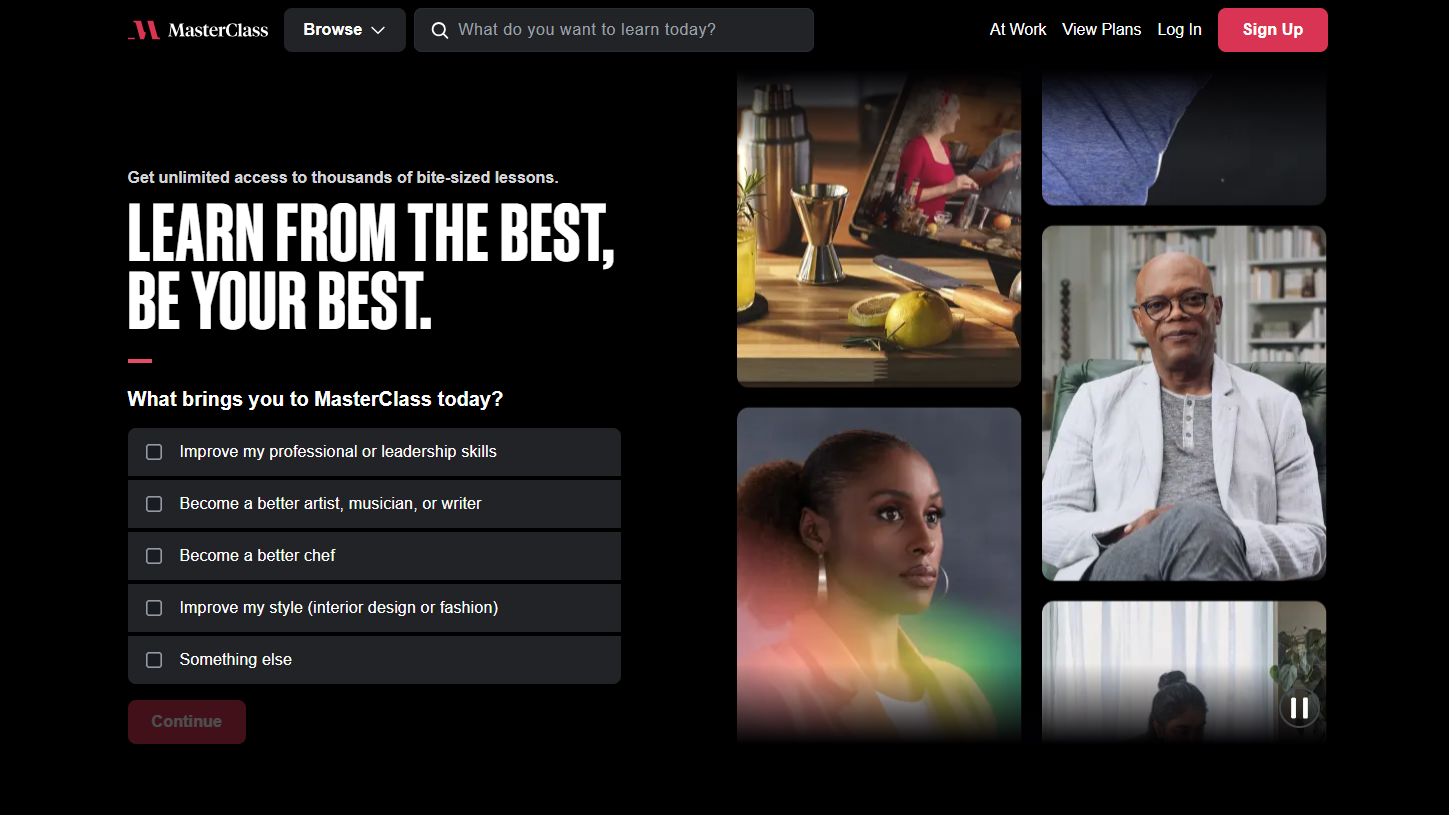
Below, you’ll find several survey questions that can help you segment your audience:
- What is your age group?
- How frequently do you visit our website?
- What best describes your primary reason for visiting our website today?
- How did you hear about our website?
- Which of the following devices do you primarily use to access our website?
- Would you like to receive personalized recommendations based on your preferences? (Yes/No)
- Which product categories are you most interested in? (Select all that apply)
- How likely are you to recommend our website to a friend or colleague?
- What factors influence your decision to make a purchase on our website? (Select all that apply)
- Which social media platforms do you use regularly? (Select all that apply)
To make sure your segmentation surveys are effective, it is important to regularly monitor and adapt them. You should update your segmentation criteria and survey questions to ensure they stay relevant over time.
Post-purchase survey questions
A post-purchase survey is a questionnaire presented to customers after they have made a purchase. It aims to gather feedback about their shopping experience and satisfaction with the product or service. Post-purchase survey questions can cover various aspects of the purchase, including product quality, delivery speed, customer service interactions, and ease of use of a website or store. Besides assessing customer satisfaction and identifying areas for improvement, companies can use feedback as testimonials to build trust and credibility with their prospects.
When creating a post-purchase survey, there are some essential things to keep in mind:
- Start with a short query. A multiple-choice or “yes/no” question can encourage customers to take your survey, as they typically don’t take much time to participate.
- Provide an incentive. After a purchase, some users might not want to spend time on a survey, especially if it consists of multiple steps. To motivate them to participate, consider offering incentives like discounts on future purchases or loyalty points.
- Focus on one aspect. Tailor your survey questions to a specific element of your customer experience, for instance, product quality, shipping speed, or customer service.
- Respect your customers’ privacy. If you are going to make post-purchase feedback from your customers public, it’s essential to inform them about it during the survey process or ask for their permission either at the beginning or the end of your survey.
Tortuga offers an open-ended survey after purchase, tailored to whether a customer is new or returning. In this website survey example, a question is addressed to a returning customer to determine why they decided to purchase again.
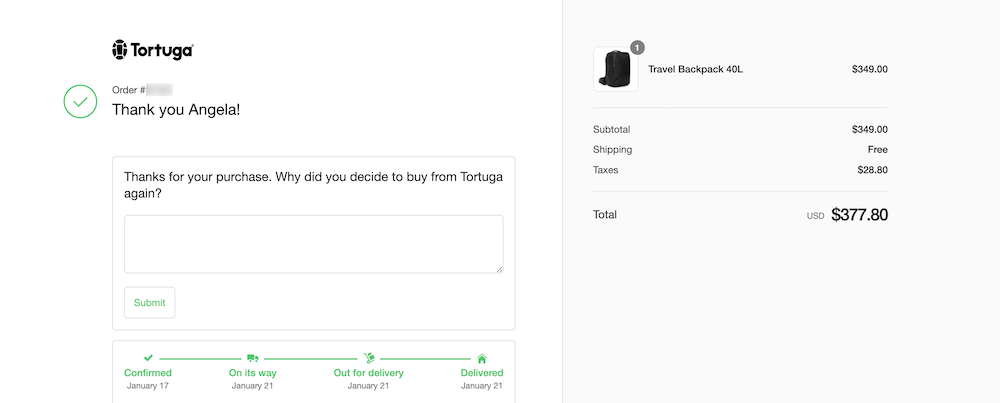
To assess your customer experience after a purchase, you can use these survey questions:
- Is there anything that almost prevented you from purchasing today?
- How would you rate your overall shopping experience with us?
- What led you to choosing our web store over other options you were considering?
- Did you interact with our customer service team during your purchase today?
- How satisfied were you with the assistance provided by our customer service team?
- What influenced your decision to purchase from us today? (Select all that apply)
- How likely are you to recommend our products/services to others?
- How easy was it to navigate our website and make your purchase?
- Do you intend to make future purchases from our website?
- Do you have any suggestions for how we can improve your shopping experience in the future?
You can combine different questions in your survey or ask a particular set of questions depending on whether it’s a returning customer or a new user.
How to launch a website survey with SendPulse
Using SendPulse, you can launch a website survey with a few clicks. Let’s dive into the main steps you should follow.
Create a survey
To start, go to the “Pop-ups” tab in your dashboard and select “Create a survey.” Surveys consist of several pop-ups that appear one after the other when a respondent takes a specified action. You can add as many pop-ups as you need and rearrange their order if necessary.
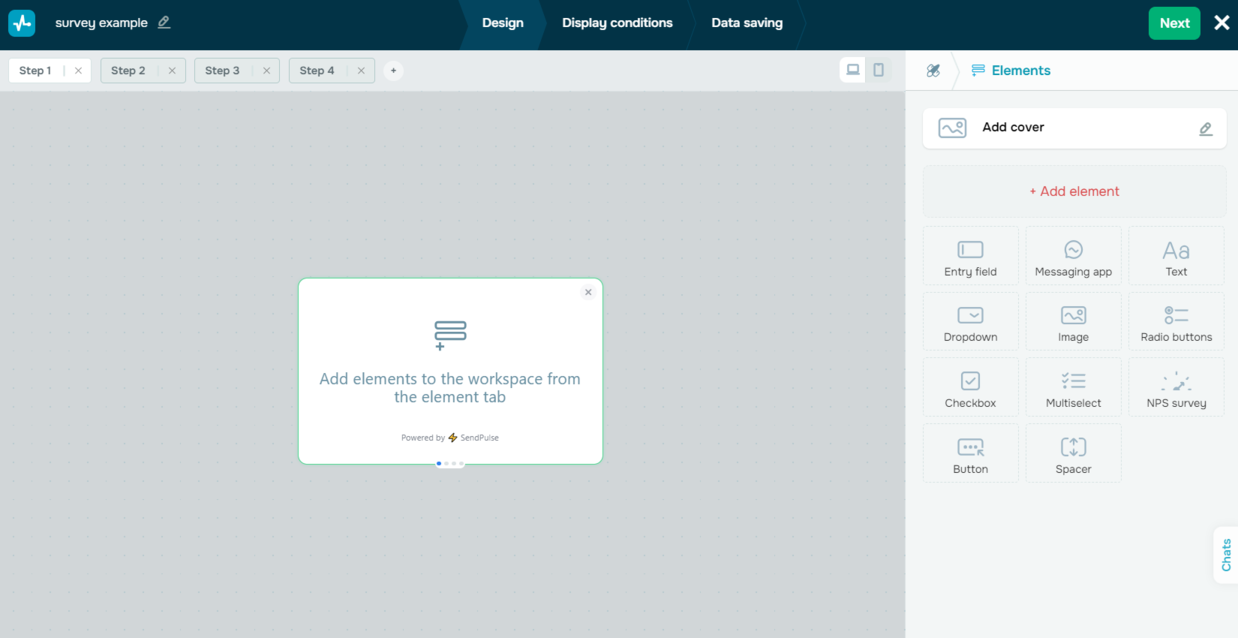
Customize your survey
After you’ve created a structure, you can customize your website survey— select a pop-up type and placement, its width and padding, colors, and animation effects.
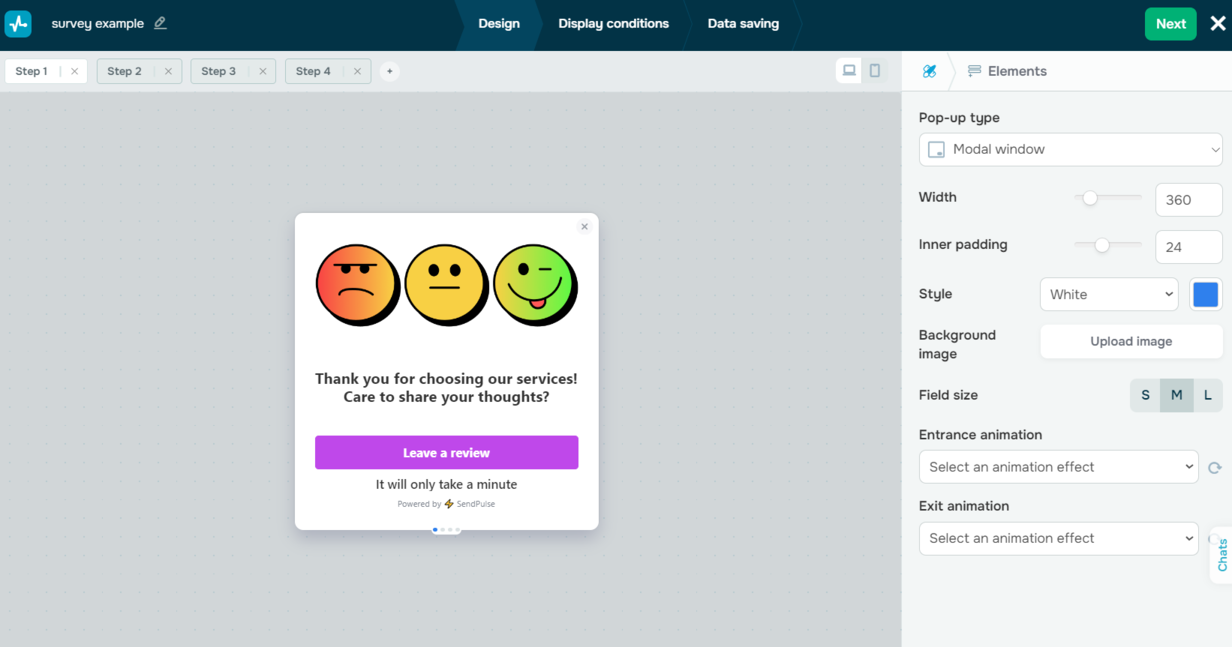
At this point, you can also write your website survey questions and modify answer options if it’s a close-ended question form or leave a response box for open-ended questions.
Set display rules
When you’re satisfied with your survey’s appearance, you can set up and combine your pop-up display conditions — there are various options grouped by frequency, time, user behavior, clicks, pages and URLs, UTM parameters, and visitor data. At this step, you can also specify where you want to store your survey participants’ data.
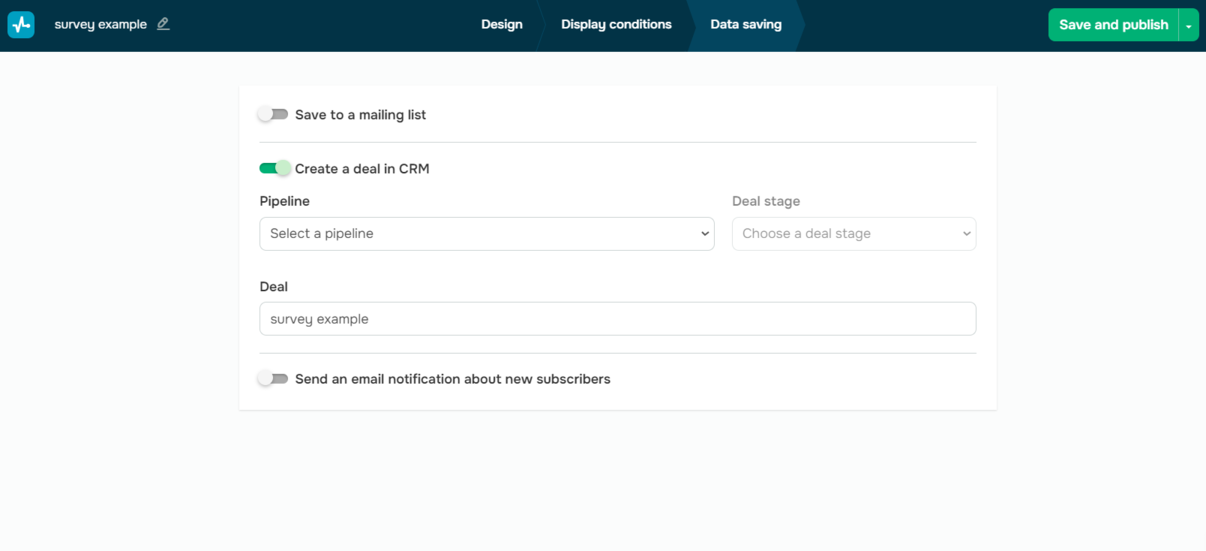
Once everything is set, you can preview your survey or click “Save and Publish” to make your survey appear on your website.
The bottom line
The success of your survey depends heavily on the questions you ask. Whether you use open-ended questions, rating scales, or multiple-choice questions, the key is to determine the exact purpose of your survey and tailor your questions accordingly to get meaningful responses from your participants.
If you’re looking for a platform to launch your website survey without coding skills, SendPulse has got you covered. Not only can you create surveys for free, but you can also access a range of other valuable tools to connect and engage with your prospects and customers. Don’t hesitate to sign up for a free account and give it a try!








